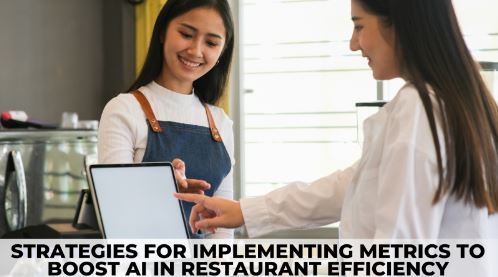Strategies for Implementing Metrics to Boost AI in Restaurant Efficiency
The secret to success lies not just in adopting cutting-edge technology but in harnessing it effectively. Imagine transforming your restaurant into a well-oiled machine where every decision is backed by data. That’s the power of leveraging artificial intelligence (AI) in conjunction with robust metrics. Rather than viewing AI as a standalone tool, restaurant owners and managers should integrate it into their decision-making processes to drive continuous improvement.
By focusing on key metrics, you can optimize operations, elevate customer experiences, and ultimately enhance your bottom line. Ready to explore how metrics can unlock the full potential of AI in your restaurant? Let’s dive in!
Identifying Key Metrics for AI Implementation
AI in customer service can streamline responses, offering personalized and efficient support to enhance the overall dining experience. If you are going to use AI in your restaurant, you need to be focused on metrics that matter to your business. Consider these four performance measurement criteria:
- Customer Satisfaction: Track metrics like customer feedback scores, repeat visit rates, and online reviews to gauge the impact of AI-driven personalized recommendations, menu customization, or improved service speed.
- Operational Efficiency: Monitor metrics such as processing time, table turnover rates, and kitchen workflow optimization to see how AI tools streamline operations and reduce bottlenecks.
- Financial Performance: Analyze revenue growth, cost savings from inventory management, and reduced waste to measure the financial impact of AI on profitability and resource allocation.
- Employee Productivity: Evaluate metrics like task completion time, labour cost per service, and employee engagement to assess how AI tools enhance staff efficiency and reduce manual workload.
If you track metrics from these categories, it will compile into a comprehensive data set that AI can render into, to find patterns, predict trends, and suggest optimizations.
Leveraging AI for Customer Satisfaction
AI-driven systems can significantly enhance customer satisfaction by analyzing data from various sources. Implement metrics such as Net Promoter Score (NPS), customer feedback ratings, wait times, and accuracy to fuel your AI-powered customer experience initiatives. With these metrics in place, AI can help you predict customer preferences and personalize recommendations, optimize seating arrangements to minimize wait times, and identify potential issues before they escalate.
Boosting Operational Efficiency with AI
Operational efficiency is crucial for restaurant success. Implementing the right kpi for restaurant operations, such as table turnover rate, kitchen efficiency ratio, and inventory turnover, can significantly impact overall performance. By tracking these metrics, AI systems can help optimize staffing levels, streamline kitchen processes, reduce food waste, and automate inventory management.
Enhancing Financial Performance through AI Analysis
AI-driven decision-making requires financial metrics. Focus on key indicators such as Revenue per Available Seat Hour (RevPASH), Cost of Goods Sold (COGS) Percentage, Labor Cost Percentage, and Prime Cost to effectively measure and enhance your restaurant’s financial performance.
These metrics help your AI to optimize pricing around demand and competition, understand cost-saving opportunities in your supply chain, and forecast revenue and expense with better confidence.
Maximizing Employee Productivity with AI Insights
Employee productivity directly impacts your restaurant’s success. Track metrics like sales per labour hour, employee turnover rate, training completion rate, and upsell percentage to leverage AI for workforce optimization. AI can utilize this data to create optimal employee schedules based on predicted demand, identify top-performing employees and replicate their success, and personalized training programs for individual staff members.
Implementing AI-Powered Phone Systems
One area where AI can significantly impact restaurant efficiency is in phone systems. An AI-driven restaurant answering service can streamline communication and improve customer experience. Consider these metrics when implementing an AI phone answering system:
- Call Volume
- Average Call Duration
- Peak Call Times
- Reservation Conversion Rate
By tracking these metrics, your AI phone system can handle multiple calls simultaneously, reducing wait times, providing accurate information about menu items, specials, and availability, and efficiently managing reservations and handling customer inquiries.
Comparing AI Solutions for Restaurants
When selecting AI solutions for your restaurant, consider how they align with your specific needs and metrics. Here’s a comparison of different AI applications:
| AI Application | Primary Metrics | Key Benefits | Implementation Complexity |
| Customer Analytics | NPS, Feedback Ratings | Personalized experiences, Improved satisfaction | Medium |
| Inventory Management | Inventory Turnover, Food Waste % | Reduced waste | Low |
| Staffing Optimization | Sales per Labor Hour, Table Turnover Rate | Improved efficiency, Reduced labour costs | Medium |
| Menu Engineering | RevPASH, COGS % | Increased profitability, Optimized pricing | High |
| Phone Answering System | Call Volume, Reservation Conversion Rate | Enhanced customer service, Efficient communication | Low |
Overcoming Challenges in AI Implementation
While AI offers tremendous benefits, implementing these systems can present challenges. Address these common obstacles: Data Quality, Staff Training, Integration, and Privacy Concerns. Ensure your metrics are accurate and consistently tracked. Invest in training programs to help employees adapt to new AI-driven systems.
Choose AI solutions that integrate seamlessly with your existing technology stack. Implement robust data protection measures to safeguard customer information. By proactively addressing these challenges, you’ll set your restaurant up for success in AI implementation.
Measuring the Impact of AI on Restaurant Performance
To justify your investment in AI technology, it’s crucial to measure its impact on your restaurant’s performance. Implement these strategies:
- Establish baseline metrics before AI implementation
- Set clear goals and KPIs for AI-driven improvements
- Regularly review and analyze performance data
- Conduct A/B tests to compare AI-driven processes with traditional methods
By consistently measuring and analyzing the impact of AI on your restaurant’s performance, you can fine-tune your strategies and maximize the benefits of this technology.
Conclusion
Metrics for boosting AI in restaurant efficiency are a must in today’s fast-moving industry. Using AI to improve your restaurant means focusing on metrics that include key criteria such as customer satisfaction, operational efficiency, and financial performance as well as employee productivity.
The bottom line is you must choose the right metrics that you will measure and be able to optimize over time, alongside the correct AI solution so you can implement it in time. Discover the potential of AI and data-driven decision-making as a means to turn your restaurant into an example of operational excellence and greatness.
By setting kitchen kpi restaurant operations create the data foundation on which to build AI systems that generate meaningful insights and viable improvements across all areas of restaurant management.
FAQs
- How can I ensure my staff embraces AI technology in our restaurant?
Focus on clear communication and comprehensive training. Explain the benefits of AI for both the business and employees, such as reduced workload and improved customer satisfaction. Provide hands-on training sessions and ongoing support to help staff feel comfortable with new AI-driven systems.
- What’s the typical return on investment (ROI) for implementing AI in a restaurant?
ROI can vary widely depending on the specific AI solutions implemented and the size of your restaurant. However, many restaurants report significant improvements in efficiency and profitability within 6-12 months of implementation. It’s crucial to track your metrics closely to measure your specific ROI.
- How can small restaurants with limited budgets leverage AI technology?
Start small and focus on high-impact areas. Consider implementing an AI-driven phone answering system or inventory management solution as a first step. These typically have lower implementation costs and can provide quick wins in efficiency and customer service. As you see returns, you can gradually expand your AI initiatives.





